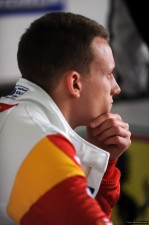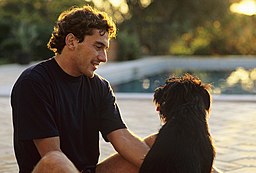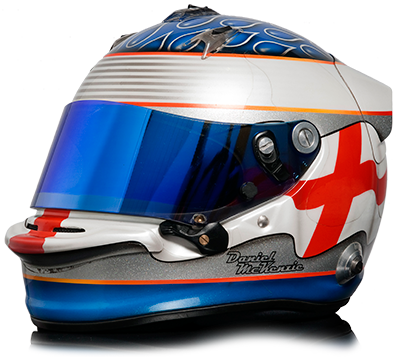In May this year Daniel and the European Le Mans Series arrived at Imola for the second round of the championship. The iconic Italian circuit is a place of history and legend at any time, but that month was special – it was the 20th anniversary of the crash that claimed a giant of our sport. Daniel tells David Ironmonger what it was like to race at the home of Ferrari, when the world was remembering Ayrton Senna.
Rossi, Earnhardt, Loeb, Fangio, Fogarty – all names that have engraved themselves on the hearts of motorsport fans around the world. But when we look at the influence and legacies of some of the greatest racers, none quite strike passion into the soul like the name of Ayrton Senna.
Considered by many to be the greatest Formula 1 driver of all time, history records how the 1994 San Marino Grand Prix at the fabled Autodromo Enzo e Dino Ferrari would see his triumphal career end in tragedy.
It’s a day that lives on in infamy. Despite the passing years, to many lovers of motorsport the memory is as raw as if it had happened yesterday and to race on such a emotional occasion is to experience the depth of that feeling first-hand.
For Daniel McKenzie, preparing for what would eventually be a class podium in his JMW Motorsport Ferrari 458 GT, the anniversary and the emotions it stirred up were obvious from start of the weekend.

A thoughtful Daniel during the Imola weekend
“It was eerie,” he said. “Being so close to the anniversary of Senna and Ratzenberger, on our cycle around of the circuit we could see all the tributes to both drivers – flowers, letters, pictures all stuck to the walls. All kinds of messages, people were walking around going to that.”
The tributes Daniel speaks of, laid out all over the track and especially around the bend where the tragedy occurred, Taburello, were the response of ordinary race fans in a period during which the whole sport remembered the past.
At the time Formula 1 was a very dangerous sport and deaths would happen far too often. Even though Daniel isn’t old enough to remember the day and the harrowing events, he still realises the sheer volume of history of the sport he now passionately loves: “It probably wasn’t until I was about eight years old that I got interested in racing, and I didn’t really start to look properly into the history of Formula One until later when I was getting into karting.
“Before then I was a footballer, and I could almost name every player in every Premiership team for the last five years. But when I had my injury and lost the chance of a professional career in the game I turned to motorsport as a way of continuing in competitive sport, and that was when I started to look seriously at the history of racing the personalities, the events and the dangers too.”

Ayrton Senna. Photo from senna.org.br [CC-BY-2.0 (http://creativecommons.org/licenses/by/2.0)], via Wikimedia Commons
With the release of the Senna motion picture which documented his childhood, rise to fame and death, numerous documentaries by the likes of Top Gear and articles written yearly by the likes of Murray Walker online, avoiding him in the media was impossible at that time.
“The significance of the weekend was that it was so close to the 20th anniversary, and you couldn’t turn on the television without seeing a story about it. It was massively in the public eye. And of course there was the Senna film too, the weekend was something that had been built up to, and actually being in Imola for it was a big deal.”
One of the great problems of the Senna tragedy is that we sometimes overlook the death of Roland Ratzenberger because his name was never put up against the lights to be seen. But the sudden loss of someone who was only a rookie must equally never be forgotten – and Daniel was pleased to see recognition of him, too.
“It was strange turning up at the circuit to see all the tributes and memories and bits and pieces all around the circuit,” he said. “It shows how much he meant to people, but it wasn’t just Senna either, Ratzenberger was commemorated too and it was obvious that he also meant a lot to people.
“The circuit is very similar to Monza in that it’s in the middle of a public park. People drive their road cars on a public road 10ft from the track. So it was very easy for people to get into it to pay their respects, and people seemed to have come from all over Italy. When we were cycling the track, one person even shouted a question to us. People came to see the race, but also the tributes.”
Because Daniel was driving a Ferrari at the home of Ferrari you could imagine that the weight of expectation on his shoulders would have made many of us crumble. Surely the additional memories hanging over the weekend could only add to the pressure?
According to Daniel, after taking in the tributes at the start of the weekend, he and the team then had to focus so entirely on the race they had no choice but to put the subject to one side. Once he was alone in the car, though, it was a different matter.
“Over the weekend it wasn’t really discussed – but it was certainly in my mind driving around,” he said. “On the grid waiting for the start I was thinking what an odd experience it was to be there, and during the race of course I could see where they both went off. It was strange to drive past the places where they left us in this world.
“Probably if you race there regularly it’s something that you get used to and it becomes not such a big deal. For me though, being there for the first time on the anniversary, as well as being in a Ferrari in front of Italian fans at Imola, it was a big thing.”

